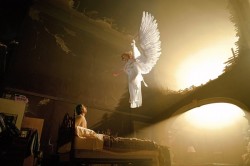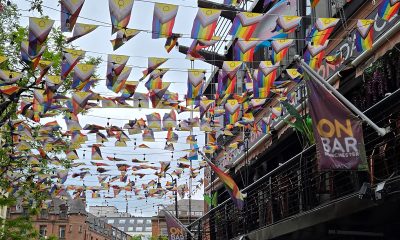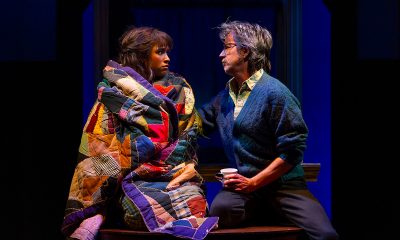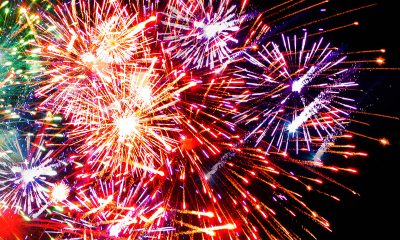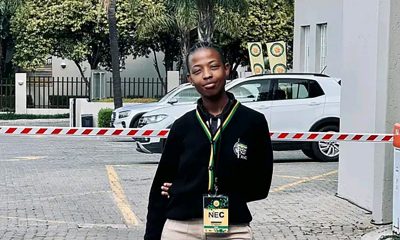Arts & Entertainment
AIDS and the arts
From the Quilt to Hollywood to Broadway, pop culture helped us make sense of grief, loss
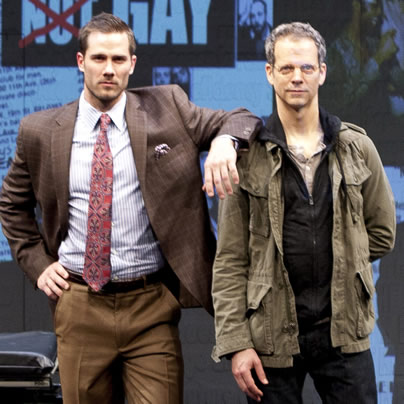
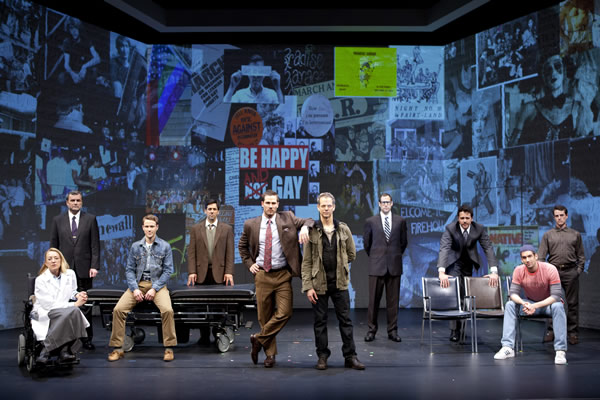
The cast of ‘The Normal Heart’ at Arena Stage. The show, a groundbreaking dramatization of the early years of the AIDS crisis in New York, runs through July 29. (Photo by Scott Suchman; courtesy Arena)
The International AIDS Conference in Washington offers an opportunity to look back at how artists have responded to the disease. Since the very first days of the crisis, artists of all kinds have actively responded, both in their artistic works and as fundraisers and activists.
THE NAMES PROJECT AIDS MEMORIAL QUILT
The Names Project AIDS Memorial Quilt, on display throughout the city through the month of July, is the largest community art project in the world. More than 48,000 panels have been created by lovers, family members and friends to memorialize those who have died of AIDS. The Quilt has redefined the traditional folk-art of quilt-making into a modern art form that serves as a memorial, a tool for education, a work of art and a call to arms. Each of the panels has been photographically preserved in the AIDS Memorial Quilt Archive. About 14 million around the world have seen panels from the Quilt.
The Quilt has its root in a powerful piece of political theater. While preparing for the annual candlelight march honoring Harvey Milk and George Moscone in 1985, San Francisco activist Cleve Jones was shocked to learn that more than 1,000 people in the city had already died of AIDS. He asked his friends to bring placards with the names of the dead to the march. After the march, the activists taped the placards to the side of the San Francisco Federal Building and realized that the signs now looked like a patchwork quilt. Inspired by the sight, Jones and his friends made plans for a larger memorial and in 1986 Jones created the first quilt panel in honor of his friend Marvin Feldman.
THE ART OF ACTIVISM
One of the remarkable features of the fight against AIDS has been the ability to use visual art to generate a powerful public response. This was especially true for the AIDS Coalition to Unleash Power (ACT UP), an international direct action advocacy group that worked to impact the lives of people with AIDS. Founded in New York City in 1987, the leaderless anarchist network effectively combined powerful direct action protests with provocative visual images to effectively generate media attention for their cause.
Veteran media activist Cathy Renna, who describes herself as “coming out and coming of age” when ACT UP was forming, says the global impact of the group came from its ability to use visual art to drive home a message.
“They had people like Ann Northrup and Larry Kramer who understood the media really well and who understood the power of images,” Renna says. “They created iconic images that demanded the attention of the media and became embedded in the minds of people.”
Renna notes that the members of ACT UP really showed the power of visual art to move people and the power of creativity and humor to reach people.
“Not everyone agreed with their tactics, but at the end of the day none of us can argue with the indelible impact they had on the public perception of AIDS and the entire LGBT movement,” she says.
CLASSICAL MUSIC
For centuries, there’s been a debate about how well classical music can respond to specific cultural events. Gay composer John Corigliano leapt into this fray when he wrote his Symphony No. 1 in 1991 as a response to the AIDS epidemic.
“During the past decade I have lost many friends and colleagues to the AIDS epidemic, Corigliano writes in his notes to the first recording of the symphony. “My First Symphony was generated by feelings of loss, anger and frustration.”
Corigliano, best known for his opera “The Ghost of Versailles” and his Oscar-winning score for “The Red Violin,” says that the form of his AIDS symphony was inspired by a viewing of the NAMES Project AIDS Memorial Quilt.
“A few years ago I was extremely moved when I first saw ‘The Quilt,’ an ambitious interweaving of several thousand fabric panels, each memorializing a person who had died of AIDS, and most importantly, each designed and constructed by his or her loved ones,” he wrote. “This made me want to memorialize in music those I have lost, and reflect on those I am losing.”
THEATER
Perhaps no other artistic medium has been as responsive to the AIDS crisis as theater. From ground-breaking pieces like Larry Kramer’s “The Normal Heart” (an Arena Stage production runs through July 29) and William Hoffman’s “As Is” to such recent works as “The Book of Mormon.” The theatrical community has been deeply involved in the artistic and activist response to AIDS. Here’s a sampling of plays and musicals that have AIDS as a central theme.
“Angels in America: A Gay Fantasia on National Themes.” Part One of Tony Kushner’s sprawling epic (“Millennium Approaches”) opened on Broadway in May 1993, and Part Two (“Perestroika”) followed in November of that year. The play centers on Prior Walter, a gay man in Manhattan who has just been diagnosed with AIDS as the play opens. Over the course of the seven-hour theatrical extravaganza, Prior is abandoned by his lover Louis, who leaves him for a closeted Republican lawyer; befriends the Mormon’s mother and wife, who takes Valium in “wee little fistfuls,” is nursed by his ex-lover, the fierce snap queen Belize; and, is visited by an angel who wants to recruit him as a prophet. The play won the Pulitzer Prize and several Tony Awards and was adapted into both an award-winning movie by HBO Films and an opera by Hungarian composer Péter Eötvös.
“The Normal Heart” by Larry Kramer was one of the earliest plays to deal with AIDS. Now playing at Arena Stage, the play is a thinly veiled autobiography of the author and the founding of Gay Men’s Health Crisis.
“Before It Hits Home” by Cheryl West was one of the first dramas to focus on the impact of AIDS on the African-American community. Wendal is a bisexual jazz musician who denies his sexual encounters with men even after he is diagnosed with AIDS. He tries to hide the truth from his pregnant girlfriend and his married boyfriend, but as his health deteriorates, he is forced to return to his family and confess the truth.
“Rent” is Jonathan Larson’s hit musical and a loose adaptation of Puccini’s “La Boehme” set on the lower East Side of Manhattan in the early 1980s. Larson’s musical landscape includes a variety of artists in a variety of straight and LGBT sexual situations. Many of the characters have AIDS and the Act II opener, “Seasons of Love” has become a popular anthem for the fight against AIDS.
The musical “Falsettos,” produced in Washington in 2010 by the now-closed Ganymede Arts, brings together two one-act musicals by William Finn written a decade apart. In “March of the Falsettos,” Marvin moves in with his male lover Whizzer, much to the distress of his ex-wife, his psychiatrist and his son. In “Falsettoland,” the extended family, now including “the lesbians from next door,” reunite to support Whizzer and Marvin as they deal with an AIDS diagnosis.
Perhaps most noticeably in theater, it’s possible to also trace how AIDS dramas have evolved over the years.
“’The Normal Heart’ was so significant in its time, but it’s dated now because the disease has changed so much,” says David Jobin, executive director of the Gay Men’s Chorus of Washington, a group that along with its sister choruses has also dealt extensively with AIDS themes. “You see plays now, like ‘Octopus’ by Steve Yockey and it’s dealing with how different generations have responded to the crisis. We now have a whole generation of people whose experience is different and it’s not about loss at all. … all people could concentrate on in ‘The Normal Heart’ was grieving, so it’s become like ‘The Dollhouse,’ a great period piece but not really relevant to today. Which is great in a way that something that’s only 20 years old can already seem so dated. It shows how far we’ve come in treating the disease.”
Jobin says the greatest examples of AIDS-themed art transcend their subject matter.
“You watch something like the HBO adaptation of ‘Angels in America,’ and it becomes so much more than just a statement about AIDS,” he says. “It’s a tour de force for great acting and it’s in a league of its own. I can’t think of a musical or other work that even comes close.”
ARTISTS AS ACTIVISTS
The theatrical community, and the performing arts community in general, have also been incredibly effective at blending art and activism. For example, since 1987 Broadway Cares/Equity Fights AIDS has been raising awareness and funds for AIDS organizations throughout the country. Their popular fundraisers include Broadway Bares, Broadway Barks, Broadway Bears, the annual Easter Bonnet and Gypsy of the Year competitions and the Fire Island Dance Festival.
One of the group’s most effective efforts has been its collaboration with the International Thespian Society, a national network of high school theater troupes. Starting in 1999, high school thespians have organized audience appeals, bucket brigades, silent auctions and special performances to raise money to fight AIDS.
During their annual festival in July 2012, Joe Norton, Broadway Cares’ director of education and outreach, announced that the student artists and activists had raised more than $1 million to support organizations in their communities.
“Thespians know how to effect change by working together and celebrating their love of theater,” Norton says. “And, in the process, they become leaders who raise awareness about HIV/AIDS where they live, while making a difference for so many people in need in their local communities and around the country.”
TELEVISION
Sometimes the artistic response to AIDS has been more about context than content. The popular nighttime ABC soap opera “Dynasty” was groundbreaking in its portrayal of Steven Carrington, the openly gay son of a wealthy Denver oil clan. But its role in the emerging AIDS crisis was due to an off-screen drama.
In 1984, closeted gay Hollywood icon Rock Hudson was cast as Daniel Reece, father of the scheming Sammy Jo Carrington (Heather Locklear). Hudson’s character had a romantic interest in Krystle Carrington, played by series star Linda Evans. Although viewers gossiped about Hudson’s gaunt appearance and producers were worried enough about Hudson’s health to write his character out of the series, no one blinked an eye when Hudson and Evans shared an on-screen kiss.
That changed on July 25, 1985 when Hudson publicly announced that he had AIDS, the first celebrity to reveal his HIV status. He learned that he had AIDS while he was appearing on “Dynasty,” and the soap set suddenly became the focus of a public health controversy. The CDC warned the public about exchanging saliva with members of high-risk groups. Aaron Spelling and the producers of “Dynasty” offered to arrange for AIDS tests for the entire cast. The Screen Actors Guild wrote new rules to regulate on-screen kisses.
Hudson’s revelation, and the subsequent revelation of his homosexuality, suddenly put a public face on the disease and his death on Oct. 2, 1985 set the stage for the first television movie on AIDS. On Nov. 11, 1985, NBC broadcast “An Early Frost” starring Aidan Quinn as Michael Pearson, a successful Chicago lawyer who has not told his colleagues and family about his lover Peter Hilton (D.W. Moffett). When he’s diagnosed with AIDS, he’s forced to go home and tell his family the truth about himself.
MOVIES
A short sampler of independent and mainstream movies that have dealt directly with the AIDS crisis include:
“Parting Glances,” Bill Sherwood’s moving 1986 indie film that was one of the first to deal with AIDS. Richard Ganoung plays Michael who is dealing with concurrent crises: caring for his ex-lover Nick (Steve Buscemi) while his lover Robert (John Bolger) is preparing to leave for a two-year work assignment in Africa.
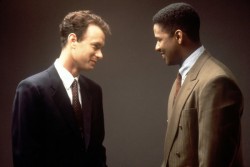
Tom Hanks (left) and Denzel Washington in ‘Philadelphia,’ a 1993 AIDS-themed Jonathan Demme movie. (Still courtesy TriStar Pictures)
“Philadelphia,” Jonathan Demme’s 1993 drama that was among the first mainstream Hollywood movies to deal with AIDS. Tom Hanks won a Best Actor Oscar for his performance as Andrew Beckett, a closeted lawyer who is fired from his conservative law office when his partners learn he has AIDS. Denzel Washington plays Joe Miller, a homophobic lawyer who helps Beckett sue his former law firm.
“Longtime Companion,” is a 1990 film that takes its title from the homophobic term used by the New York Times and other newspapers to refer to the surviving partners of deceased gay men. It chronicles the early years of the AIDS epidemic from the 1981 article on the mysterious disease occurring among gay men to the beginnings of AIDS activism.
“Tongues Untied” is Marlon Riggs’ stunning 1989 film sought to “shatter the nation’s silence on matters of sexual and racial difference.” It combines documentary footage with fictional stories and episodes from Riggs’ life, as well as footage from civil rights marches and a homophobic stand-up routine by comedian Eddie Murphy.
FICTION
Since the 1980s, countless novelists have tackled the topic of AIDS. From early efforts, such as Armistead Maupin’s “Tales of the City” series to recent books such as Edmund White’s “Jack Holmes and His Friend,” the novel has been a fertile ground for exploring the devastating impact of AIDS on individuals and their society.
One of the most controversial has been “People in Trouble” by lesbian writer and activist Sarah Schulman. The novel deals with a love triangle among artists in the East Village. The controversy, however, arose from Schulman’s accusation that Jonathan Larson lifted the gay plot of “Rent” from her novel. In her 1998 book “Stagestruck: Theater, AIDS and the Marketing of Gay America,” she details the similarities between the two works and critiques how Larson depicts LGBT people and people with AIDS.
Examples
THEATER
Terrence Mc Nally, “Love! Valour! Compassion!”
Cheryl West, “Before It Hits Home”
William Finn, “Falsettos”
William Hoffman, “As Is”
Jonathan Larson, “Rent”
Paula Vogel, “The Baltimore Waltz”
Paul Rudnick, “Jeffrey”
Harvey Fierstein, “Safe Sex”
Larry Kramer, “The Normal Heart” and “The Destiny of Me”
Tony Kushner, “Angels in America”
Robert Lopez, Matt Stone and Trey Parker, “The Book of Mormon”
Broadway Cares/Equity Fights AIDS
POETRY
Mark Doty, “My Alexandria”
Essex Hemphill, “Ceremonies”
Marie Howe, “What the Living Do”
Paul Monette, “Love Alone: 18 Elegies for Rog”
Rafael Campo, “What the Body Told”
Tim Dlugos, “Powerless”
Tory Dent, “What Silence Equals”
TELEVISION
“An Early Frost”
“Dynasty”
“Another World”
“As The World Turns”
“Common Threads: Stories from the Quilt”
“And The Band Played On”
“The Real World”
“Any Mother’s Son”
“In The Gloaming”
FICTION
Christopher Bram, “In Memory of Angel Clare”
Sarah Schulman, “People in Trouble”
Alice Hoffman, “At Risk”
Armistead Maupin, “Tales of the City”
Paul Monette, “Afterlife”
Edmund White, “Jack Holmes and his Friend”
Dale Peck, “Martin and John”
E. Lynn Harris, “Invisible Life”
Felice Picano, “Like People in History”
Sapphire, “Push”
David B. Feinberg, “Spontaneous Combustion”
Samuel R. Delaney, “The Tale of Plagues and Carnivals”
Geoff Ryman, “Was”
CLASSICAL MUSIC
John Corigliano, “Symphony No. 1”
“Classical Action”
MUSIC
“NakedMen”
“Exile”
“Metamorphosis”
“In This Life” by Madonna (from “Erotica”)
ARTS ACTIVISM
ACT UP
Broadway Cares
Names Project AIDS Memorial Quilt
ESSAY
Susan Sontag, “AIDS and Its Metaphors”
Larry Kramer, “The Tragedy of Today’s Gays”
MEMOIRS
Paul Monette, “Borrowed Time”
Reinaldo Areñas, “Before Night Falls”
Mark Doty, “Heaven’s Coast”
Derek Jarman, “At Your Own Risk”
Jamaica Kincaid, “My Brother”Paula W, Peterson, “Women in the Grove”
John Preston, “Winter’s Light”
David Wojnarowicz, “In the Shadow of the American Dream”
PERFORMANCE ART
Ron Athey
Ron Vawter
David Drake
MOVIES
“Longtime Companions”
“Parting Glances”
“Paris is Burning”
“Philadelphia”
“Patient Zero”
“The Living End”
“The Hours”
“It’s My Party”
“Tongues Untied”
VISUAL ARTS
Visual AIDS
Keith Haring
ACT UP and Gran Fury
DANCE
Bill T. Jones, Absence
Neil Greenbery, Not-About AIDS-Dance
UCLA Dance Marathon
Dancers Responding to AIDS
Travel
Manchester is vibrant tapestry of culture, history, and Pride
Alan Turning Memorial is among English city’s many attractions
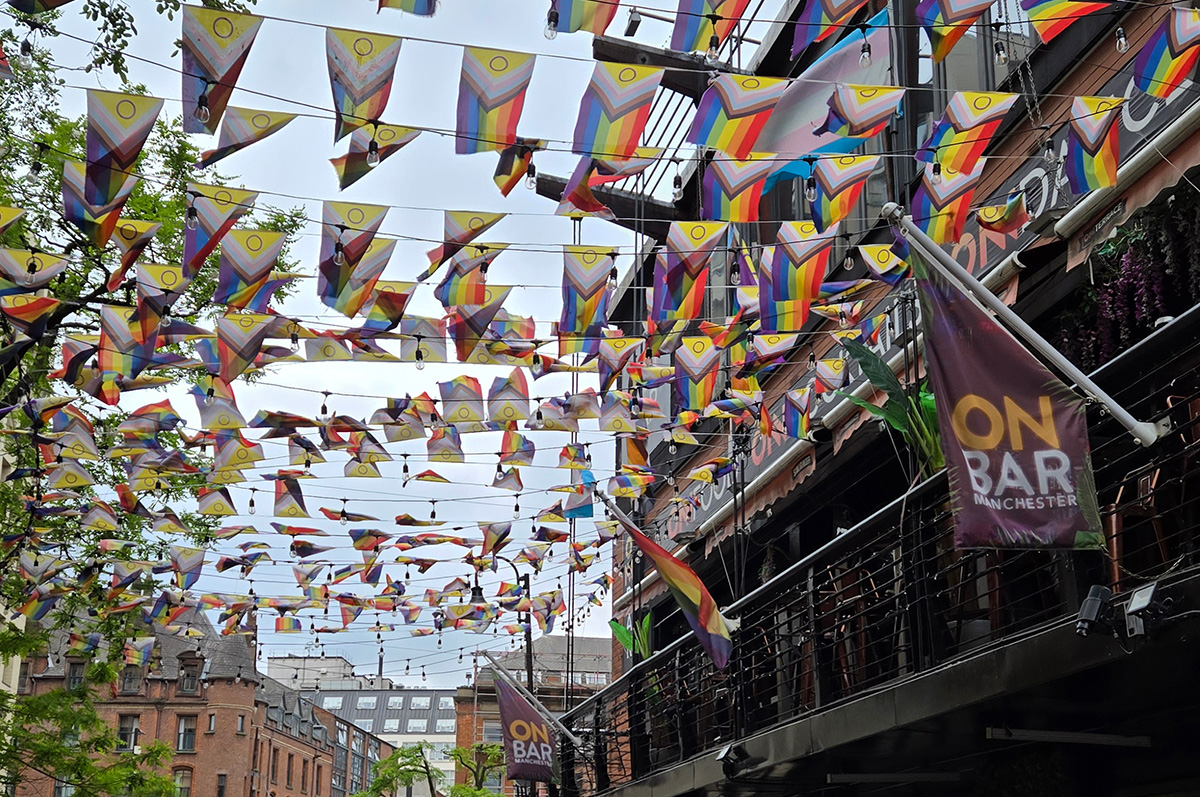
Manchester, England, is not only famous for its industrial heritage, music scene, and football clubs — it’s also home to one of the most vibrant and historically significant LGBTQ communities in the U.K. Often referred to as the “gay capital of the North,” Manchester has been a pioneer in LGBTQ rights, visibility, and celebration, cultivating a culture of inclusivity that continues to thrive today.
The roots of Manchester’s LGBTQ history stretch back centuries, but it was during the 20th century that the city truly became a hub for activism and progress. In 1880, a scandal known as the “Manchester Drag Ball” brought national attention to the city when police raided a fancy dress ball attended by men in drag. Though the incident was used to stigmatize the community, it also marked one of the first widely publicized moments of queer expression in the city.
Manchester is home to several institutions that preserve and celebrate queer history. The LGBT Foundation, based in the city, is one of the U.K.’s leading LGBTQ charities, providing health and support services as well as educational resources.
The city is also immortalized in pop culture as the backdrop for “Queer as Folk,” the groundbreaking 1999 television series created by Russell T. Davies. The show, set in Manchester’s Gay Village, helped bring the realities of LGBTQ life to mainstream audiences and played a pivotal role in shaping public attitudes.
Manchester, is a city that lives and breathes resilience. It’s a place where cobblestone streets echo with the voices of industrial workers, punk rockers, activists, and proud members of the LGBTQ community. I came here seeking stories — some hidden in old libraries, others pulsing through neon-lit streets — and left with a sense of belonging I hadn’t expected.
My base for this journey was the magnificent Kimpton Clocktower Hotel. Located in a former insurance building dating back to the 1890s, it seamlessly marries historic grandeur with modern luxury. Walking through its doors felt like entering a different era. The soaring ceilings, intricate tilework, and dramatic staircases told stories of old Manchester, while the in-room record players spinning tracks by Oasis made sure I knew exactly where I was.
The heart of the hotel is The Refuge, a restaurant and bar that buzzes with energy. Whether sipping cocktails beneath the Winter Garden’s lush greenery or sharing small plates that borrow flavors from around the world, I felt immersed in the city’s welcoming vibe. Even in its luxury, the Kimpton feels like a place for everyone, especially when there is a DJ spinning some cool jazzy beats.
One thing I loved about this property is their “Forgot it? We’ve got it” service. Whether its toothpaste, a shaving kit, or phone charger, the helpful staff have you covered. I tend to forget at least one necessity on every trip. The Kimpton’s central location places guests within walking distance of Manchester’s vibrant cultural scene, including the Palace Theatre, Canal Street, and various shopping and dining options.
My first stop in Manchester was the John Rylands Library, an architectural marvel of neo-Gothic design. I was there specifically to view “The Secret Public” exhibition. It traces Manchester’s underground art scene, especially its ties to queer culture and punk resistance. Flyers, magazines, and photographs are on display.
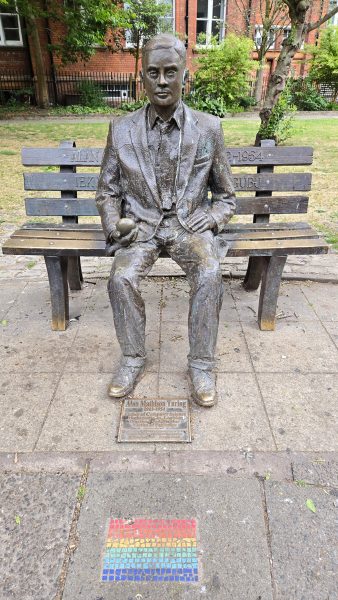
And while we are on the topic of LGBTQ history, the best way to understand Manchester’s queer roots is by talking to the locals. The Free Manchester Walking Tours offers a Queer History Tour, led by passionate guides who have in depth knowledge of the city’s LGBTQ history and culture. We began our tour in Sackville Gardens, home to the Alan Turing Memorial and the Beacon of Hope, a tribute to those affected by HIV/AIDS. It’s a space for reflection, nestled just beside Canal Street’s constant thrum. For those not familiar with Alan Turing, he was a pioneering mathematician and computer scientist, best known for his role in cracking the German Enigma code during World War II, a breakthrough that helped shorten the war and save countless lives. Often regarded as the father of modern computing, Turing laid the theoretical foundation for artificial intelligence. Despite his monumental contributions, he was persecuted for being gay, ultimately leading to his tragic death in 1954. Today, he is celebrated as both a scientific genius and a symbol of the ongoing struggle for LGBTQ rights.
No trip to Manchester would be complete without a night — or three — spent in the Gay Village. Centered around Canal Street, it’s a place that radiates warmth and freedom. What once was a hidden, underground scene in the 1980s has become a global symbol of LGBTQ pride.
During the day, you’ll find people sipping coffee along the canal and by night, the rainbow flags light up the street. Spaces like Via and the Eagle pulse with music and laughter, while Cruz 101 remains a sacred institution for dancefloor devotees. This is more than a party district; it’s a cultural hub, one that has helped shape national conversations and lead by example.
Manchester’s gay scene is more than just nightlife. In the Northern Quarter, I stumbled into Feel Good Club. a queer-owned café that quickly became one of my favorite stops during my trip. Feel Good Club is a café but the space also hosts workshops, mental wellness events, and spontaneous conversations with strangers who somehow feel like old friends. I ordered a bowl of apple-soaked oats and I have to say, it was one of the most delicious and inexpensive things I ate during my entire trip to England. I should have asked for the recipe!
A few blocks away sits Queer Lit, an LGBTQ bookstore filled to the brim with stories I wish I’d had growing up. From queer romance and fiction to books on trans identity and intersectionality, the shop is both cozy and revolutionary. Queer Lit claims to have the largest selection of LGBTQ books in all of Europe. Beyond books, the store hosts events such as workshops, live readings, and book clubs, providing a safe and inclusive space for the community to gather and celebrate queer literature. They also serve a variety of beverages. I would definitely recommend trying one of their hot chocolate drinks.
Though my trip didn’t coincide with Manchester Pride, visitors can expect tens of thousands each August. Pride here features a blend of celebration and activism. From glitter-filled marches to thoughtful panel discussions, it’s a reflection of the city itself: joyful, inclusive, and unafraid to speak truth to power. Importantly, the money raised goes straight back into the community, funding LGBTQ+ health initiatives, charities, and support services. Also in August is SCENE, Manchester’s LGBTQ+ Film and TV Festival, which consists of a week of new and classic LGBTQ cinema and TV screenings, panels, and other events.
All this touring and learning about queer history made me hungry, so for dinner, I ventured to Maray, a Middle Eastern-inspired gem in the city center. Its signature “Disco Cauliflower” — roasted whole and topped with tahini, pomegranate, and harissa — was a revelation. The food, like the city, defied expectations. It was spicy, complex and comforting. I would also recommend trying the crispy sea bass with broccoli slaw. Maray’s vibe is relaxed yet refined, a perfect place to unwind after a day of exploration. Its inclusive, welcoming spirit felt aligned with everything I’d experienced in Manchester so far.
For a more casual dining experience, head over to Freight Island, a unique food hall and entertainment venue located near Piccadilly Station. The venue features a variety of locally owned food stalls including Mia’s Arepas, Ornella’s Little Kitchen and Mega Gyros. It’s a great place to grab a quick bite or cocktail after work with friends.
Manchester may not be as polished as London, but that adds to its charm and intrigue. I tend to enjoy cities like Manchester over their larger neighbors. During my entire stay, I was able to walk to every attraction I visited and by experience, the best way to see a city is on foot. It’s also a great way to burn off those extra calories.
Whether you’re wandering Canal Street at sunset, or simply sipping hot chocolate at Queer Lit, Manchester is a place where you can be yourself and belong.
Enjoy the journey!
Books
Embracing the chaos can be part of the fun
‘Make Sure You Die Screaming’ offers many twists and turns
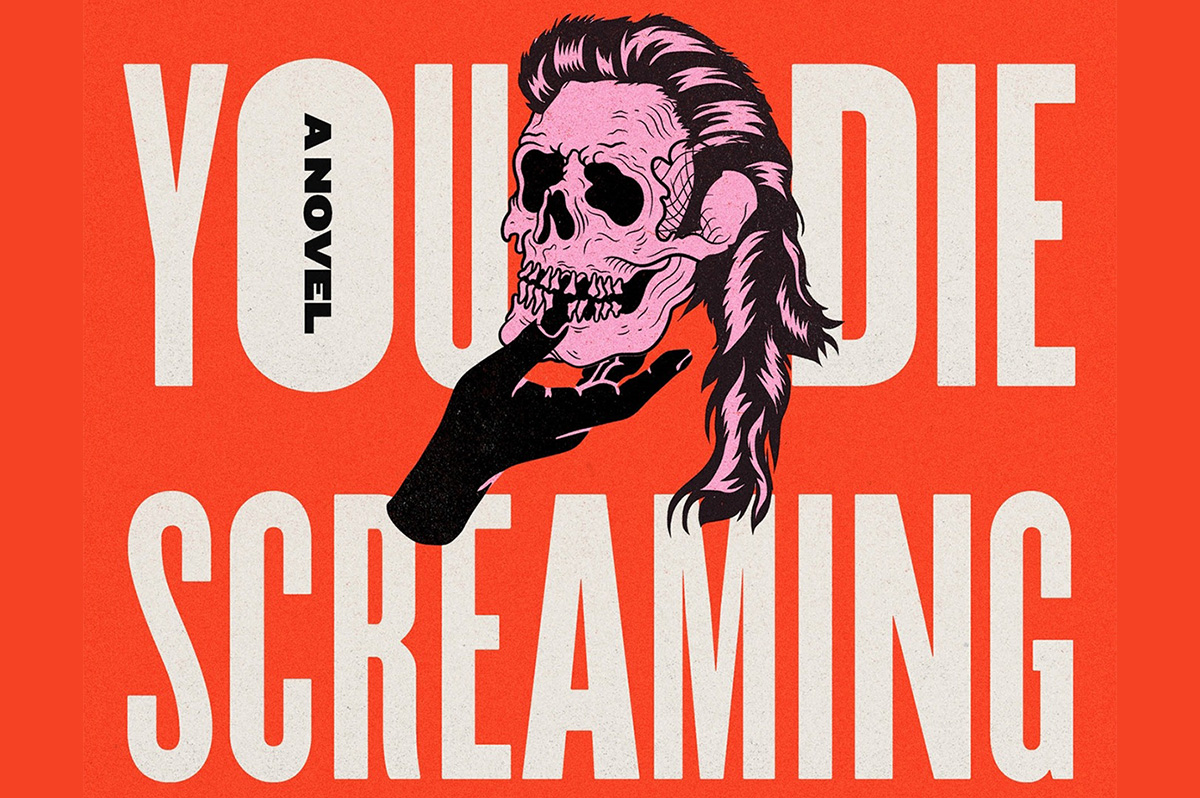
‘Make Sure You Die Screaming’
By Zee Carlstrom
c.2025, Random House
$28/304 pages
Sometimes, you just want to shut the door and forget what’s on the other side.
You could just wipe it from your memory, like it didn’t occur. Or create an alternate universe where bad things never happen to you and where, as in the new novel “Make Sure You Die Screaming” by Zee Carlstrom, you can pretend not to care.

Their mother called them “Holden,” but they’d stopped using that name and they hadn’t decided what to use now. What do you call an alcoholic, queer, pessimistic former ad executive who’s also “The World’s First Honest White Man,” although they no longer identify as a man? It’s a conundrum that they’ll have to figure out soon because a cop’s been following them almost since they left Chicago with Yivi, their psychic new best friend.
Until yesterday, they’d been sleeping on a futon in some lady’s basement, drinking whatever Yivi mixed, and trying not to think about Jenny. They killed Jenny, they’re sure of it. And that’s one reason why it’s prudent to freak out about the cop.
The other reason is that the car they’re driving was stolen from their ex-boyfriend who probably doesn’t know it’s gone yet.
This road trip wasn’t exactly well-planned. Their mother called, saying they were needed in Arkansas to find their father, who’d gone missing so, against their better judgment, they packed as much alcohol as Yivi could find and headed south. Their dad had always been unique, a cruel man, abusive, intractable; he suffered from PTSD, and probably another half-dozen acronyms, the doctors were never sure. They didn’t want to find him, but their mother called…
It was probably for the best; Yivi claimed that a drug dealer was chasing her, and leaving Chicago seemed like a good thing.
They wanted a drink more than anything. Except maybe not more than they wanted to escape thoughts of their old life, of Jenny and her death. And the more miles that passed, the closer they came to the end of the road.
If you think there’s a real possibility that “Make Sure You Die Screaming” might run off the rails a time or three, you’re right. It’s really out there, but not always in a bad way. Reading it, in fact, is like squatting down in a wet, stinky alley just after the trash collector has come: it’s filthy, dank, and profanity-filled. Then again, it’s also absurd and dark and philosophical, highly enjoyable but also satisfying and a little disturbing; Palahniuk-like but less metaphoric.
That’s a stew that works and author Zee Carlstrom stirs it well, with characters who are sardonic and witty while fighting the feeling that they’re unredeemable losers – which they’re not, and that becomes obvious.
You’ll see that all the way to one of the weirdest endings ever.
Readers who can withstand this book’s utter confusion by remembering that chaos is half the point will enjoy taking the road trip inside “Make Sure You Die Screaming.”
Just buckle up tight. Then shut the door, and read.
The Blade may receive commissions from qualifying purchases made via this post.
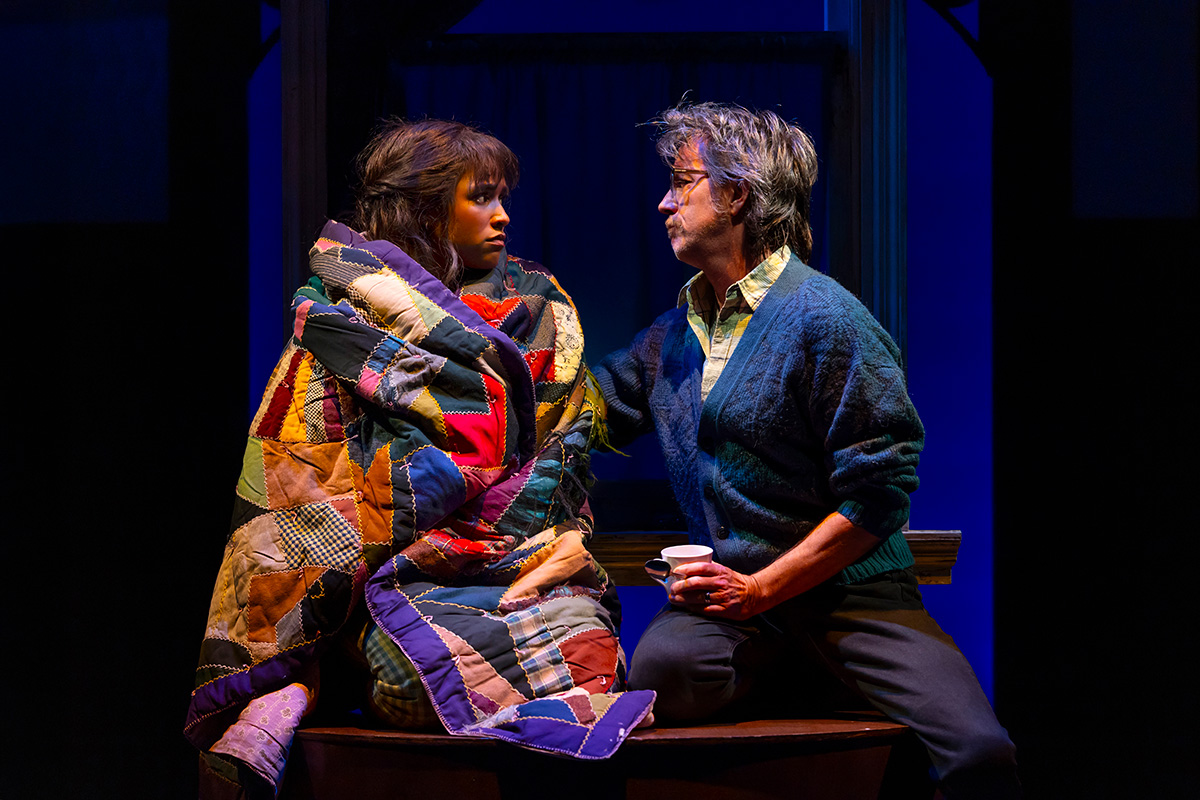
‘A Wrinkle in Time’
Through July 20
Arena Stage
1101 Sixth St., S.W.
Tickets range from $59-$209
Arenastage.org
Currently at Arena Stage, talented out actor and singer Taylor Iman Jones is rekindling an old friendship with an adored character of fiction.
Broadway vet Jones is starring as 13-year-old Meg Murry in “A Wrinkle in Time,” the world-premiere musical adaptation of Madeleine L’Engle’s same-titled book.
For many readers, especially women, the classic 1962 young adult novel, was their first foray into sci-fi, particularly one with a female protagonist.
The story centers on Meg, an awkward schoolgirl whose physicist father has mysteriously disappeared. Now, Meg, her popular friend Calvin, and smart younger brother Charles Wallace are tasked with moving through time and space to find him. Along the way they encounter adventure and evil.
For Jones, 33, playing 13-year-old Meg feels freeing in ways. She says, “As you get older, you’re told to grow up, so I like letting go of some of that. To feel feelings in their rawest form and to tap back into that is fun. I like the spontaneity. There are highs and lows to revisit.”
Born and raised in the San Francisco Bay Area, Jones began piano lessons at just six and soon added band and plays to their pursuits. Following high school, she made a deep dive into California theater for seven years before making the big move to New York in 2017 where after just two months she was singing on Broadway.
The determined and appealing Jones, who lives in New York with their partner, boasts an impressive bio. She has appeared on Broadway as Catherine Parr, Henry VIII’s sixth and final wife in Six, and in the original casts of “Head Over Heels” and “Groundhog Day.” She’s been seen in national tours of “Hamilton” and “American Idiot.”
WASHINGTON BLADE: It seems “A Wrinkle in Time” and Meg mean a lot to a lot of people.
TAYLOR IMAN JONES: The book tells the story of a girl with so much undiscovered power who’s accomplishing things she never imagined that she could.
BLADE: Can you relate?
JONES: Meg wears her emotions on her sleeve. I can certainly relate to that. I’m a Pisces. Sometimes being hyperemotional and very empathetic can feel like a burden, but as I’ve matured, I have realized that it’s not a bad quality. And it’s something I’ve learned to harness and to enjoy. I love that I can play a role like Meg in front of thousands of people.
BLADE: Was “Wrinkle in Time” a book you knew well?
JONES: Oh yeah, it’s a favorite book that lives in my heart and my mind. It’s one of the first books that taught me about the adventure of reading.
BLADE: And playing a favorite character must be a kick.
JONES: It really is.
BLADE: Meg is a big part in a big show.
JONES: This musical is huge. They’re traveling through space and meeting people on different planets. 20-person cast. 30 songs in the show. Quite the undertaking and I’m proud of us. I’m on stage for the entire musical and I sing four or five numbers.
As a mezzo soprano I guess you’d say I have the luxury of being able to do a lot of musicals that span a lot of different genres: rock musical, pop musical, and standards. “A Wrinkle in Time” is contemporary musical theater.
For me, singing is probably the least difficult part of the show. What’s harder for me is the way Meg experiences trauma; I need to be careful when I’m screaming and yelling.
BLADE: It seems mostly women have been involved in making this production happen (book by Lauren Yee; music and lyrics by Heather Christian; directed by Lee Sunday Evans; and choreography by Ani Taj.)
JONES: It’s true, the director, writer, etc., and most of our producers are all women. This doesn’t happen most of the time. For me it means new ideas and fresh energy, and pushing the limits of musical theater.
It’s also created a wonderful space in which to work. It can be more generous, and understanding. And centering the story on a young girl is something we can all relate to.
BLADE: Will “A Wrinkle in Time” resonate with queer theatergoers and their families?
JONES: I think so, especially on the heels of pride month. It’s truly a show for all ages about finding your inner strength and fighting for the things that you love; not letting evil win over the power of good, and not just for yourself but for those around you too.

